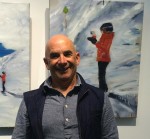Ian Penn’s exhibit Winter Paintings: The Figure in and on the Landscape opened March 10 at Zack Gallery. (photo by Olga Livshin)
The theme of Ian Penn’s solo show at Zack Gallery is winter. The artist’s love for winter, for the mountains of British Columbia and for skiing reverberates through the gallery.
“I’m affected by the seasons, by my surroundings,” said Penn in an interview with the Independent. “I only paint current seasons. In summer, I paint summer; in the fall, I paint its rioting colors. In winter, I paint snow and skiing.”
Penn spends lots of his free time in the mountains. “Our whole family likes to ski,” he said. “When we first moved to B.C., we bought our first place in the mountains before we settled in Vancouver.”
Penn has been skiing since his youth in Australia, but it was cross-country skiing until he immigrated to Canada and saw the mountains. At the age of 35, he started alpine skiing – and loved it.
Around 2000, he went a step further. He joined the ski patrol in Whistler, volunteering part-time his professional skills as a doctor. He still does that. “I like the ski patrol community. They are nice people,” he said.
About the same time, he also became seriously interested in painting, which eventually led to a degree from Emily Carr.
Penn has a general fascination with landscapes, especially mountain scenes, as an art form. He has painted dozens of landscapes, in every season, and some of his favorite areas to paint are around Whistler and the Callaghan Valley.
“I was always interested in mapping a territory, but a map and a territory are not the same,” he explained. “The painting of a landscape is not the same as if you stand in that place, experience it with all your senses. Or with devices – photo cameras and cellphones. I wanted to capture that difference in my paintings. That’s why I started a series of diptychs. My diptychs are like a single painting in two parts.”
There are several diptychs on display in the gallery. One is a landscape, a vista with the majestic mountains and forest, with tiny human figures. The second affords a closer look. The human figure is larger, the artist’s focus has narrowed, and the people in these paintings are doing something, engaging with the mountains. They whip down the slopes on their skis. They stop to take photos. They enjoy the invigorating exercise and the beauty around them. They laugh and horse around.
Penn captures their movement in his paintings. His objects are not static. They don’t pose. They are just going about their business, and the artist is going about his.
“Initially, I wanted to paint on location,” he said. “I want to paint everywhere I go, but I couldn’t do that in winter. It’s too cold both for my hands and for the paints. Or it might snow. What I do when I’m in the mountains skiing, I take photos and make quick drawings.”
The drawings provide him with the first impression, the emotional subtext. The photographs he uses for details.
“All the details in my landscapes are accurate. The precision is important to me. I want to be able to navigate by them. I want the ski patrol to be able to use my paintings when they have to rescue someone,” he said, only half-joking.
Many of his paintings have personal stories attached, some of which are more obvious than others. In one painting, there was to have been a person but there isn’t; the close-up view is surprisingly empty of life. “He got erased. I erased him,” Penn said. “He was a vain fellow. He was dancing around, making selfies of himself with his cellphone, turning so he would get every possible angle. He didn’t notice anyone else, almost stepped on my ski. At first, I wanted to show it, as a portrait of self-absorption, but I disliked the fellow so much, I finally erased his figure from my painting. But, mostly, I want my paintings to tell your stories, not mine.”
The dominating color in all of the paintings is white, of course, overset by green forest and dark mountains. Only people provide splashes of color: a red jacket or a yellow parka.
“I use five different whites for the snow,” Penn said. “And then there are color patches reflecting the surroundings. Snow is never simply white. It’s complex and a challenge. It’s always different. And so is the sky: blue but different in each painting. But I never used black in any of these paintings. When I needed the dark, I mixed colors.”
Penn paints landscapes because they are endless. “Wherever I go, there is a new and amazing landscape waiting for me. Painting them, making drawings, photographing slows me down, allows me the time to look, to see the beauty around me.”
Winter Paintings: The Figure in and on the Landscape will be at the Zack until April 3. For more information about Penn and his work, visit ianpenn.com. An interview with Penn about his exhibit last year, called Pole, can be found at jewishindependent.ca/memorials-to-millions.
Olga Livshin is a Vancouver freelance writer. She can be reached at [email protected].

